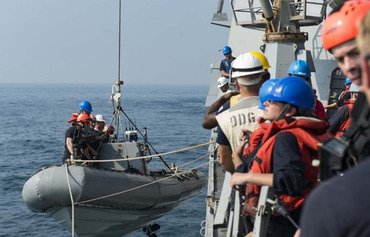MANAMA -- Iran on Monday (November 29) had still yet to comment after the US Navy on Saturday rescued two Iranian seamen who had been adrift for eight days on a fishing boat in Gulf waters.
"A US Navy vessel rescued two Iranian mariners from a fishing vessel after it was adrift for eight days in the Gulf of Oman," the US Naval Forces Central Command (NAVCENT) said in a statement.
Dry cargo ship USNS Charles Drew responded after the Combined Maritime Forces (CMF), an international maritime coalition headquartered in Bahrain, received a distress call from the stranded mariners, the navy said.
The USNS Charles Drew arrived on scene six hours later and provided food, water and medical care.
![Personnel from dry cargo ship USNS Charles Drew transport an Iranian mariner November 27 in the Gulf of Oman. Two Iranian mariners requested assistance after their fishing vessel was adrift at sea for eight days. [US Navy]](/cnmi_am/images/2021/11/29/32843-us-navy-rescue-600_384.jpg)
Personnel from dry cargo ship USNS Charles Drew transport an Iranian mariner November 27 in the Gulf of Oman. Two Iranian mariners requested assistance after their fishing vessel was adrift at sea for eight days. [US Navy]
"This is what we are trained and ready to do," said Vice Adm. Brad Cooper, commander of NAVCENT, the US Navy's 5th Fleet and the CMF.
"As professional mariners, we have a responsibility to help people in need at sea," he said.
On Sunday, the USNS Charles Drew safely transported the mariners to an Omani coast guard vessel sailing near Muscat, the navy said.
The mariners were in good health and spirits at the time of the transfer, it added.
"We appreciate the government of Oman for its assistance and support in helping us return the mariners home," Cooper said.
Where was Iranian navy?
Questions are being asked as to why, after more than a week, the Iranian navy was nowhere to be found while the two seamen were adrift in the Gulf.
Iran analysts have in recent months raised questions about the preparedness of the Iranian armed forces, amid a string of military mishaps.
The latest major naval mishap involved one of the country's largest ships, which sank June 2 after catching fire while on a "training mission" off the port of Jask in the Gulf of Oman.
"Iran's approach to military funding is problematic," a former Iranian navy analyst told Al-Mashareq in June, on condition of anonymity.
"Officials are effectively trying to fund two militaries, while showing a clear preference for the Islamic Revolutionary Guard Corps (IRGC)," he said.
"This means the conventional military is underfunded in all areas: training, equipment, weapons and hardware," he said.
"To maintain existing equipment, they keep cannibalising old military equipment manufactured before the 1979 Islamic Revolution," he said.
US-based Iran analyst Jason Bahari described the vessels of Iran's aging fleet as "floating museums".
"The government retrofits them with rocket launchers and slightly tweaked radars," he explained. "But the basic technology is 50 years old or older."
Aging equipment is just part of the problem, analysts said, noting that the IRGC Navy's unprofessional conduct has drawn international rebuke, as it puts lives at risk and reflects poorly on the entire Iranian military apparatus.
The government's misplaced priorities, lack of care for the public and preference for the IRGC's regional expansionist policies have caused preventable, occasionally fatal, incidents in recent years.
International rescue operations
The personnel and ships of the 34-nation CMF are organised into three principal task forces that provide security for civilian maritime traffic by conducting counter-piracy and counter-terrorism missions.
As part of this force, the US 5th Fleet has taken part in numerous rescue operations in regional waters and has provided engineering, mechanical and medical support to vessels in distress, according to navy officials.
The US Navy has assisted numerous mariners during the course of its operations in Gulf waters and has rescued Iranian fishermen in distress on more than a dozen occasions.
On November 18, 2016, for example, the USS Nitze came to the rescue of three Iranian fishermen, whose small vessel was stranded because of a dead battery.
The crew of the USS Nitze located and identified the boat and supplied the fishermen with a new battery and a case of water.
A few days later, on November 29, 2016, two US warships deployed in support of maritime security operations came to the aid of six Iranian mariners in distress.
On that occasion, the USS Hopper and USS Monterey received a distress call from a small Iranian fishing dhow via bridge-to-bridge radio, according to NAVCENT.
The USS Monterey dispatched its helicopter to locate the vessel, while the USS Hopper prepared its boarding team to render immediate assistance to the mariners.
When the USS Hopper's sailors boarded the vessel, they found the six mariners aboard were ill. The Hopper's sailors provided the Iranian crew with medicine and departed after ensuring the crew was safe.
In January 2012, the crew of the USS Kidd, which is part of the USS John Stennis strike group, rescued 13 Iranian sailors from a fishing boat in the North Arabian Sea that had been hijacked by pirates.

![Two Iranian mariners signal for assistance November 27 in the Gulf of Oman. The USNS Charles Drew responded and provided food, water and medical care. [US Navy]](/cnmi_am/images/2021/11/29/32842-iran-mariners-distress-600_384.jpg)





